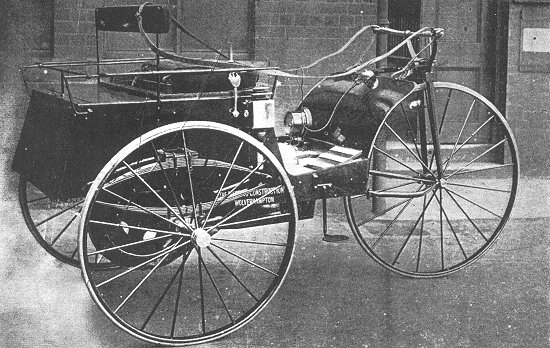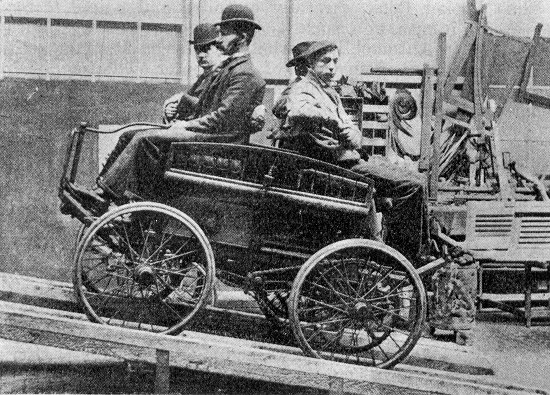E.C.C. Cars
| Thomas Hugh Parker, son of one of the founders the company, was credited with the design and manufacture of E.C.C.'s
most famous car, the 'electric dog-cart', built in 1896. |
|

The Electric Dog Cart. |
Reins were used to steer the vehicle because
Mr. A. B. Blackburn, the works manager, enjoyed horse riding.
He decided that the car had to be
as similar as possible to a horse-drawn vehicle.
The operation of the motor controller was by sliding seat.
|
| It was said by Walter "Wattie" Wall, an old employee,
who often drove the dog-cart, that the arrangement worked quite
well when the movement consisted of sliding the seat backwards,
but not so well when it was necessary to pull the seat forward.
This difficulty was overcome by screwing a half egg shaped
wooden block to the seat. It rested between the driver's legs
and provided the necessary lock between him and the seat.
The vehicle had an interesting career including a drive
through London, with the late Duke of Fife as passenger. In 1896
the car was entered in a race for self-propelled road vehicles,
from the Crystal Palace, London, to Birmingham with a prize of
1,000 guineas for the winner. The race, organised by 'The
Engineer' magazine, had 72 entries, but on the day there were only five runners,
which resulted in the event being cancelled. The car however,
was highly commended, but eventually broken-up at the works. The
electric motor
continued in use for many years, driving an ash-hoist in the E.C.C. boiler house. |
| Another view of the Electric Dog
Cart. |
 |
 |
The photograph opposite, shows a
petrol engined car
of 1897, being tested
on a 1
in 6 gradient at E.C.C.'s Bushbury works. |
| Thomas Hugh Parker designed other prototype cars for the
company including the petrol engined car above. Some of his cars
included modern features such as hydraulic brakes on all four
wheels, and four wheel steering. He claimed to have invented the
spark plug, the monoblock engine and the carburettor.
E.C.C. experimented with prototype cars for a number of years, with
the idea of producing cars commercially. This never happened, the
company dropped the idea and no further prototypes were built. |
|